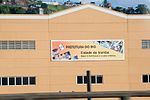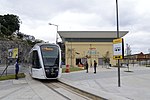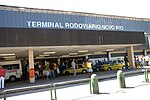The Federal University of Rio de Janeiro or University of Brazil (UFRJ; Portuguese: Universidade Federal do Rio de Janeiro or Universidade do Brasil) is a public research university located in the state of Rio de Janeiro, Brazil. It is the largest federal university in the country and is one of the Brazilian centers of excellence in teaching and research. In terms of scientific, artistic and cultural productions it is recognized nationally and internationally due to the great professors, researchers, reviews and assessments made by international agencies. In 2017 QS World University Rankings ranked UFRJ as the best Brazilian federal university, as well as the third best university in the country occupying the seventh position among institutions of Latin America. In 2016 and 2017 the Ranking Universitário Folha (RUF) ranked UFRJ as the best university in Brazil and the best Federal University in the country. The Center for World University Rankings (CWUR) published in 2017, rated UFRJ as the second best university in the world in the Zoology field.Brazil's first official higher education institution, it has operated continuously since 1792, when the "Real Academia de Artilharia, Fortificação e Desenho" (Royal Academy of Artillery, Fortification and Design, precursor to the university's current Polytechnic School) was founded, and served as basis for the country's college system since its officialization in 1920. Besides its 157 undergraduate and 580 postgraduate courses, the UFRJ is responsible for seven museums, most notably the National Museum, nine hospitals, hundreds of laboratories and research facilities and forty-three libraries. Its history and identity are closely tied to the Brazilian ambitions of forging a modern, competitive and just society.The university is located mainly in Rio de Janeiro, with satellites spreading to ten other cities. Its main campuses are the historical campus of "Praia Vermelha" (Red Beach) and the newer "Cidade Universitária" (College City), which houses the "Parque Tecnológico do Rio" (Technology Park of Rio) - a science, technology and innovation development cluster. There are also several off-campus units scattered in Rio de Janeiro: the School of Music, the College of Law Studies, the Institute of Philosophy and Social Sciences and the Institute of History, in downtown Rio; the National Museum and the Valongo Observatory (not to be confused with the National Observatory); and the high-school unit "Colégio de Aplicação" (Application College) in Lagoa. To the city of Macaé, located in the State's northern region, was dedicated a research and learning center focused on environmental issues and oil-related matters, and the city of Duque de Caxias, in partnership with the National Institute of Metrics, Normalization and Industrial Quality (Inmetro), saw the implementation of "Pólo Avançado de Xerém" (Advanced Center of Xerém), aimed at boosting research in the fields of biotechnology and nanotechnology.
UFRJ is one of the main actors in the formation of the Brazilian intellectual elite, contributing significantly to build not only the history of Rio de Janeiro but also of Brazil. Some of its former students include renowned economists Carlos Lessa and Mário Henrique Simonsen; Minister Marco Aurélio Mello; the architect Oscar Niemeyer; the philosopher and politician Roberto Mangabeira Unger; the educator Anísio Teixeira; the engineer Benjamin Constant; writers Clarice Lispector, Jorge Amado and Vinicius de Moraes; politicians Francisco Pereira Passos, Oswaldo Aranha and Pedro Calmon, besides the great physicians Carlos Chagas, Oswaldo Cruz and Vital Brazil.








